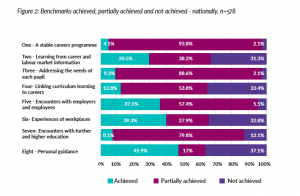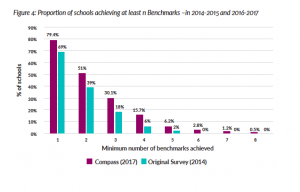Today sees the launch of the Careers and Enterprise Company’s State of the Nation report. The report explores the careers and enterprise provision in the England’s secondary schools, it covers data from 2016/2017, collected from 578 secondary schools through the Compass tool.
The data collected has enabled a comparison of how schools are performing against the Gatsby Benchmarks with some scope for comparing against the data collected as part of the original Gatsby Good Career Guidance in 2014.
The Key Findings:
1. The Gatsby Benchmarks offer a demanding but achievable standard for schools’ careers and enterprise provision. The overwhelming majority of schools (79.4%) achieve at least one Benchmark and most (51.0%) achieve at least two.
2. Some Benchmarks are easier to achieve than others. The range of achievement is between 4.2% of schools fully achieving Benchmark 1 (a stable careers programme) to 45.9% fully achieving Benchmark 8 (personal guidance).
3. Current provision in schools typically falls short of the standard set by the Gatsby Benchmarks. 20.6% of schools are not achieving any Benchmarks and on average schools are only meeting 1.87 (out of 8) of the Benchmarks.
4. A more detailed look reveals that many schools are partially meeting the Benchmarks. On average schools are meeting around 50% of the indicators that make up the Benchmarks and manage to achieve or partially achieve 6.4 out of 8 Benchmarks. In many cases there are a small number of things that schools could do to boost the number of Benchmarks that they are achieving.
5. There is evidence of improvement since the original Gatsby survey in 2014. Schools in 2016/2017 are achieving an average of half a Benchmark more than they were in 2014/2015 (1.87 versus 1.34). The proportion of schools not achieving any Benchmarks has fallen by one third from 31% to 21%. The proportion of schools achieving half the Benchmarks has more than doubled from 6% to 16%. There were also some schools achieving six, seven or eight of the Benchmarks in 2016/2017 while the best schools in 2014/2015 were only achieving five Benchmarks.
6. There is no statistically significant relationship between the characteristics of the school or the labour market in which it is situated and the number of Benchmarks achieved. This is encouraging as it suggests that schools that want to meet the Benchmarks can do so regardless of their pupil intake or local labour market conditions.
7. There is a relationship between the number of Benchmarks achieved and the region in which the school is located. It is not clear what accounts for this relationship and this may merit further research.
8. There is a statistically significant relationship between schools’ performance against the Benchmarks and whether they have a sixth form or not with schools without 6th forms performing better against the Benchmarks. This is accounted for by the fact that schools with a sixth form are less likely to provide students with an opportunity to encounter further education. This finding confirms the concerns of the further education sector and advocates for technical education.
9. There is a statistically significant relationship between getting a higher Ofsted grade and meeting more indicators that make up the Benchmarks. Outstanding schools typically achieved 60.1% of the sub-Benchmarks while other schools only achieve 53.1% of the sub-Benchmarks.
10. There is a statistically significant relationship between schools which hold the Quality in Careers Standard and those which meet more Benchmarks and sub-Benchmarks. On average schools with the Quality in Careers Standard are meeting more than one additional Benchmark than those that do not hold it.
The report takes the helpful step of highlighting key activities to get schools moving in the right direction and suggest substantial initiatives to support improvement.

The Gatsby Benchmarks are a robust set of guidelines which are arguably difficult to achieve . The report shows that 79.4% of schools achieve at least one and around half of schools achieved two or more. The benchmarks most likely to be achieved are encounters with employers, personal guidance and experiences of workplaces – this indicate that employers are becoming more involved and understanding their important role in inspiring young people in to work but more work needs to be done to understand how and why this is working and other benchmarks remain harder to achieve for schools.
Progress

The number of schools hitting no benchmarks at all has dropped to 21% to 31%, the proportion hitting half the benchmark has risen to 16% from 6%. The numbers still show patchy careers provision for young people.
The report shows there has been some progress, whilst on the surface the numbers aren’t huge there are some glimmers of hope as schools move to being ‘partially achieved’ with plans in place to become ‘achieved’.
What makes the difference?
The report suggests further research will be needed to explore regional differences in attaining Gatsby Benchmarks – there is a difference regionally but what makes that difference isn’t clear. It is interesting to note what doesn’t make a difference: school characteristics, the number of disadvantaged students for example has no link to achieving Gatsby Benchmarks.
Schools with a sixth form achieve 1.7 benchmarks whilst schools without a sixth form achieve 2.3 – a difference of half a Benchmark. Schools with good OFSTED results also perform better against the benchmarks.
What’s Next:
We are pleased to see impact measurement reporting coming through to better understand and test what is working. We, like many others believe that young people should have impartial access to careers information and guidance and support to effectively transition from education to employment. It is important to note the work taking place to improve this but with a raft of education and policy changes and no clear careers strategy to be seen concern still remains around the patchy nature of careers support.
Schools are facing a tough few years with the Ebacc, the introduction of T-Levels, the Apprenticeship Levy and GCSE grade changes (to name but a few!) there are real concerns on the time and capacity of our schools network to continue to deliver against Gatsby Benchmarks without any indication of extra support or funding..
Next Steps:
Our Young Professional Membership is free to 14 – 24 year olds, it offers ongoing skill development challenges and a raft of resources to support young people.
Our new Careers Hub gives impartial information on career roles and sectors
Our Community Membership supports employers on their journey to becoming more youth friendly







